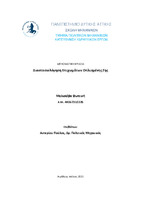| dc.contributor.advisor | Asteriou, Pavlos | |
| dc.contributor.author | Μαλισιόβα, Φωτεινή | |
| dc.date.accessioned | 2021-08-02T13:31:43Z | |
| dc.date.available | 2021-08-02T13:31:43Z | |
| dc.date.issued | 2021-07-08 | |
| dc.identifier.uri | https://polynoe.lib.uniwa.gr/xmlui/handle/11400/1044 | |
| dc.identifier.uri | http://dx.doi.org/10.26265/polynoe-895 | |
| dc.description.abstract | Στην παρούσα διπλωματική εργασία παρουσιάζονται οι βασικές αρχές των επιχωμάτων οπλισμένης γης και ορισμένα παραδείγματα επιχωμάτων που κατασκευάστηκαν στην Ελλάδα. Γίνεται ανασκόπηση των μεθόδων διαστασιολόγησης επιχωμάτων οπλισμένης γης βάσει του αμερικανικού και βρετανικού κανονισμού και της μεθόδου των λωρίδων. Στη συνέχεια, αναπτύσσεται υπολογιστικό φύλλο excel, το οποίο υπολογίζει τη συνολική απαιτούμενη δύναμη ενίσχυσης επιχωμάτων χονδρόκοκκου και λεπτόκοκκου υλικού με τη μέθοδο οριακής ισορροπίας του βρετανικού κανονισμού, γνωστή ως τη μέθοδο δύο σφηνών. Για την αξιολόγηση της μεθόδου έγιναν παραμετρικές αναλύσεις σε πρανή ύψους Η=10m, 15m, 20m, μεταβάλλοντας τις αναγκαίες στρώσεις ενίσχυσης με γεωπλέγματα διαφορετικής εφελκυστικής αντοχής 80kN/m και 110kN/m σε χονδρόκοκκα και λεπτόκοκκα υλικά. Έπειτα, τα παραπάνω προσομοιώματα, αναλύονται με τη βοήθεια του προγράμματος slide και προκύπτουν οι αντίστοιχοι συντελεστές ασφαλείας, έτσι ώστε να διαπιστωθεί η ευστάθεια κάθε ενός από τα παραπάνω επιχώματα, μετά την τοποθέτηση των ενισχύσεων που λαμβάνονται από τους αντίστοιχους υπολογισμούς του προγράμματος excel. Η ελάχιστη αποδεκτή τιμή του συντελεστή ασφαλείας βάσει του βρετανικού κανονισμού είναι FS ≥ 1.3. Καταλήγοντας, συγκρίνονται και αξιολογούνται τα αποτελέσματα των αναλύσεων που πραγματοποιήθηκαν, προκύπτουν τα ανάλογα συμπεράσματα και προτείνονται ορισμένες λύσεις αντιμετώπισης ενδεχόμενης αστοχίας πρανών. | el |
| dc.format.extent | 162 | el |
| dc.language.iso | el | el |
| dc.publisher | Πανεπιστήμιο Δυτικής Αττικής | el |
| dc.rights | Αναφορά Δημιουργού - Μη Εμπορική Χρήση - Παρόμοια Διανομή 4.0 Διεθνές | * |
| dc.rights | Attribution-NonCommercial-NoDerivatives 4.0 Διεθνές | * |
| dc.rights.uri | http://creativecommons.org/licenses/by-nc-nd/4.0/ | * |
| dc.subject | Επιχώματα οπλισμένης γης | el |
| dc.subject | Μέθοδος δύο σφηνών | el |
| dc.subject | Γεωπλέγματα | el |
| dc.title | Σχεδιασμός επιχωμάτων οπλισμένης γης | el |
| dc.title.alternative | Design of reinforced soil embankments | el |
| dc.type | Διπλωματική εργασία | el |
| dc.contributor.committee | Καπόγιαννη, Ελένη | |
| dc.contributor.committee | Belokas, Georgios | |
| dc.contributor.faculty | Σχολή Μηχανικών | el |
| dc.contributor.department | Τμήμα Πολιτικών Μηχανικών | el |
| dc.description.abstracttranslated | In this diploma thesis, the basic principles of reinforced soil embankments are presented, as well as some examples of embankments built in Greece. The methods of dimensioning of reinforced soil embankments, based on the American and British
regulations and the strips method. Subsequently, an excel spreadsheet is developing, which calculates the total required
reinforcement strength of embankments of coarse-grained and fine-grained material by the method of marginal equilibrium of the British regulation, known as the two-part wedge method. For the evaluation of the method, parametric analyzes are made on slopes of height H=10m, 15m and 20m, changing the necessary reinforcement layers with geogrids of different tensile strength 80 kN/m and 110 kN/m in coarse-grained and fine-grained materials. Then, the above simulations are analyzed with the help of the Slide program and the corresponding safety factors are obtained, in order to determine the stability of each of the above embankments, after the placement of the reinforcements obtained from the respective calculations of the Excel program. The minimum acceptable value of the safety factor under the UK Regulation is FS ≥ 1.3. In conclusion, the results of the analyses carried out are compared and evaluated, the corresponding conclusions are drawn and some solutions are proposed to deal with possible slope failure. | el |


